Children’s & youth bikes – Which size is the right one?
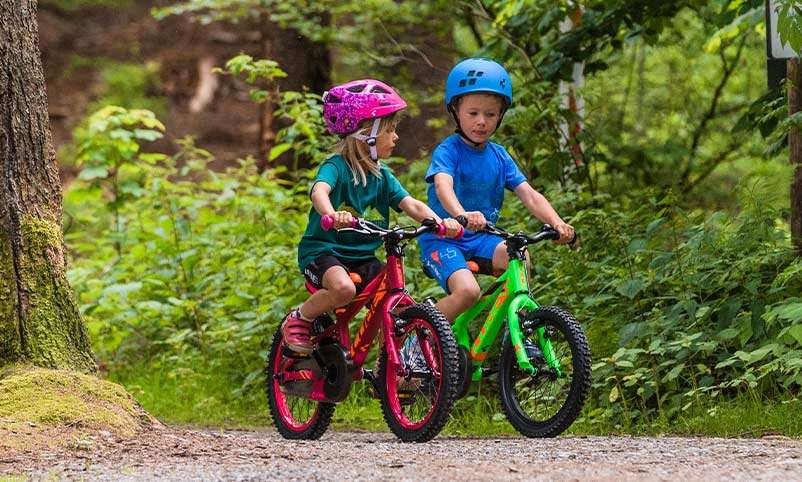
Exploring the world is probably the most amazing thing in the life of a growing little person. The first adventures are extended from the home to the nearby surroundings – a true world of wonder for a child. Snow, grass, earth, mud and rain – so many new things await, and we get to accompany our little explorers along the way. Few things give parents more pleasure than looking into the beaming eyes of children while the little bundles of energy tell us what they have experienced.
The most exciting time of our children holds our own childhood experiences in front of our eyes. We certainly remember our first bicycle, with which we moved lightly and rapidly from adventure to adventure, including many an experiment and a few scrapes. As boys, we built redoubts, ploughed through mud and showed off many times with our freehand attempts, while the girls raised their bikes to noble steeds that carried princesses and their dolls to the next fairytale castle. Our children’s imagination knows no bounds when it comes to play and it is wonderful to see them doing it.
Bicycles or even sliding vehicles are the first companions that fill our little ones with pride. Just like mum and dad, they are now also owners of a vehicle and can reach their destination much faster, can simply drive away from a nagging mum and a running dad ..
At a young age, it is not difficult to encourage the kids to exercise in the fresh air, but is one aware of laying the foundation for fun in exercise into old age at such an early age? At the end of the day, we parents have to fight against a lot of things that, in addition to school, keep many children and adolescents at home and thus tied to their desk chairs. Tablets, mobile phones, game consoles and computers rob many children of their natural movement behaviour and not infrequently their view of the outside world, which is why we cannot start early enough to make movement in nature permanently attractive and to set a good example.
If you make the bicycle a constant companion and keep the joy of cycling alive, you can be sure that your own offspring will never mutate into a sofa potato. Indifference, on the other hand, always takes its revenge. A lethargic young person is hardly enthusiastic about anything, paralysed by the media. In a completely different way, active young people participate in social life, are more empathetic, more alert and pursue their own goals. They are able to motivate themselves and do not shy away from challenges. The benefits of an active life could be extended at this point for a long time. The fact is that exercise in the fresh air directly promotes the development of mental abilities, and the differences are ultimately significant compared to those of young exercise-deprived children.
Let’s promote the good – with quality and safety!
The possibilities as a family to experience and do something together with the children even in later years are considerably expanded with bicycles. Another advantage is that exciting bicycle tours can usually be realised in the immediate vicinity. The expansion of cycling networks is taking place continuously, as federal states and municipalities have long since recognised the relevance. Fortunately, it is never too late to change something!
Passion for biking ..
… can be conveyed at a very early age. As with the right shoe, the correct size is crucial for a lot of riding fun. Only in this way can our little ones enjoy their new bike with ease and be encouraged in an age-appropriate way. Especially at the tender age of 3, our little ones are not yet musclemen/women. Therefore, we should pay attention to light frames as well as to the appropriate frame geometry. In this way, we can prevent princes/princesses from banishing their bikes to the cellar dungeon, snorting with rage and frustrated.
With children’s eyes, first and foremost a toy
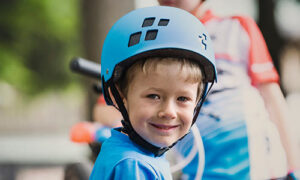
Really nice to move fast, but what’s even more important are the colours, right?
As parents, we may think otherwise, after all, safety always comes first, but we will never be able to inspire our little ones for a modern mouse grey, i.e. anthracite, instead our self-confident offspring want to identify with their bikes. Bright favourite colours are very popular, as are motifs of many comic heroes. Thanks to the courageous manufacturers who like to reach into the colour pot, our little racers quickly feel like Lightning McQueen or a cycling Spiderman. For girls, it may be pink accessories and pennants, as well as doll seats, in order to head for the next coffee party in the tree house in Princess Lillifee style. Let’s allow our children to have fun and simply take both: safety AND hip, sometimes downright “squeaky” design.
Quality please!
What we definitely want to mention here are our experiences with cheap DIY store vehicles. We absolutely must advise against this, because if too much is saved, the joy, if it can arise at all, can only be short-lived. It is better to involve family members if your wallet is a bit thin than to get a cheap little donkey that presents one shortcoming after another after the first few kilometres.
Bikes for the very youngest start at around 150 euros upwards, while larger bikes from 20 inches upwards cost between 300-1000 euros. Especially for the very young, the focus is not only on safety but also on durability. It is not uncommon for the running bike or even the first bike to have to withstand a lot, so the frame needs to be correspondingly robust.
From play to personal well-being – ultimately a contribution to oneself
For our youngest children, riding a bicycle has long been understood as a game. The transition – away from playfulness to modern and environmentally conscious locomotion – is fluid and takes place over many years. Nevertheless, one thing remains the same: The deep-seated joy of cycling and the enjoyment of this inspiring form of locomotion.
At a very early age, we pave the way for our “young ones” to learn everything that is beneficial:
To be independent and active, to develop a sense of responsibility and environmental awareness, prudence, regular behaviour, self-confidence, to do things all by themselves … – the mobility and newly learned qualities of our little ones when their bicycle becomes their new companion make us proud. Courageously and full of curiosity, they explore new areas of life, becoming more and more aware. We want to support important developmental steps in the best possible way with safe quality bikes. Of course, top advice is crucial when it comes to the right size and equipment of the bike.
Before you buy, make sure you know how safely your child can ride a bike. This information will help our sales advisors to find the right model.
From child to adolescent ..
Learning to walk opens up a whole range of new possibilities for your child. As early as two years old, you can let the little ones loose on simple walking bikes, which is the first time they start to keep their balance on a two-wheeler. Children who were able to use a running bike before they got a “real” bike find it particularly easy to learn to ride a bike – without training wheels, mind you!
Speaking of training wheels, they are only recommended to a limited extent if your child has considerable difficulties with balance and coordination. – But that’s not the case and you think training wheels are the ultimate? You need to know: Training wheels often take away children’s ability to shift their weight properly. So try it first without, be the motivating support yourself until your little cyclist happily proves what he can already do on his own!
Conclusion: Let’s support body awareness and sense of balance, yes, promote self-confidence best without training wheels … An initial parental help is usually quite sufficient. The necessary balance usually comes quickly, and once it has been “discovered”, it will not be lost again.
Our favourite brands and offers:
Scott, Cube and Puky – if you’re looking for a quality bike for your offspring, there’s no getting around these brand names. The decisive factor here is simply the sophisticated quality work, for which only reliable manufacturers stand. Precisely because safety is the most important aspect of children’s bicycles – which, by the way, costs something – a cheap or imitation model from the discounter can in no way compete. Our experience proves us right all along the line.
We keep a wide berth from the discounters of children’s bicycles and only sell bikes that we would put our own children on. Especially because kids sometimes stay out of sight with their bikes, parents have to keep a good feeling. For youngsters, on the other hand, who are increasingly taking part in road traffic, a high level of quality and thus safety is also important.
Grown again – a new bike is needed ..
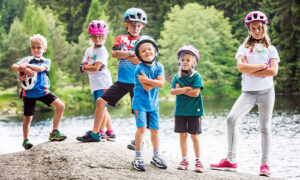
But no bike really seems to fit at the moment? In case of doubt, it’s a good idea to wait and see before buying the next bigger bike. Our little ones grow incessantly, but often in spurts. So it can happen that no perfect size can be found, because the offspring may stand exactly between two inch measurements. Fortunately, a break in growth lasts for a few months at most, so that after six months at the latest, the next larger bike can finally be purchased.
The wait is well worth it: especially when your child is riding in traffic, the right size is an important safety factor. If you go for an oversized bike, you can get your child into serious trouble. Safety when cycling begins not least with the optimal riding experience. Sometimes stopping and starting must function smoothly.
Well-known manufacturers always have their own priorities in addition to the focus on safety: Scott, for example, tailors the frame geometry perfectly to children without overstretching the budget. Particular emphasis is placed on durability
With Cube, kids are more likely to enjoy directional stability, a high level of riding comfort and smooth gears, and the manufacturer’s look is strongly oriented towards adult bikes. Reliable, with easy handling and precise design, these manufacturers as well as Puky score equally and thus promote coordination and motor skills in the youngest children in an age-appropriate way.

CONCRETE – geometry, brakes, gears ..
Low-entry bikes are best suited for beginners. It is also generally advantageous to involve the child directly in the purchase if you are not completely sure which model is suitable for your offspring.
The frame geometry of some children’s bikes is inspired by MTBs, which goes down very well with kids because the sporty look with the high top tube quickly wins them over. However, if your child has problems getting on and off the bike, it’s always better to go for a low-entry bike like a Wave frame, especially if enthusiastic cyclists are still a bit wobbly. Those who are looking towards a BMX should bear in mind that these bikes do not offer any safety. They are not sufficiently equipped for road traffic.
When test-riding your child, make sure that he or she sits upright. Your child should find this position comfortable. They should be able to reach the ground with their feet, and their arms and legs should be relaxed and slightly bent during the ride, not stretched out. This guarantees easy steering and good control. You may prefer an angle-adjustable stem that grows with your child and can be adjusted.
Which size is right for my child? – Age, size and inches ..
- At the age of 2, or from a height of 75 cm, a simple children’s wheel is recommended. Four-wheeled pushchairs are also suitable, as are play bikes from 12 inches upwards.
- From the age of 3 – 4 years, as soon as your offspring has reached or exceeded 95 cm, you can go for a children’s play bike with 14 inches
- If your child is 110 cm or taller, children’s play bikes between 16 and 18 inches are suitable
- From 120 cm (approx. 6 years), 20 inch children’s bikes are suitable
- At a height of 135 cm, 24 inch children’s bikes are suitable
- From 145 cm upwards, 26 inch children’s bicycles are suitable
| Height | Age | Bicycle size |
| 85 – 100 cm | 2 – 5 | Children’s wheel (8 or 10 inch) |
| 85 – 100 cm | 2 – 4 | 12 inch |
| 95 – 110 cm | 3 – 5 | 14 inch |
| 110 – 120 cm | 5 – 7 | 16 inch |
| 115 – 130 cm | 6 – 8 | 18 inch |
| 120 -135 cm | 7 – 9 | 20 inch |
| 135 – 145 cm | 9 – 11 | 24 inch |
| 145 cm + | 11 + | 26 inch (youth bike) |
Finding the right size for your offspring can sometimes be quite tricky, especially if the look is more important to the child than the optimal riding experience. We don’t leave you alone with this. Our competent sales advisors can help you in an experienced and comprehensive way, so that you can enjoy your new bike for a long time.
Gear system
We distinguish between hub gears and derailleur gears. With derailleur gears, regular maintenance is obligatory, as these systems are susceptible to dirt and also take some knocks and falls badly. Otherwise, you can be happy about the price and the direct power transmission. The hub gears, on the other hand, can – unlike the derailleur gears – only be repaired by a specialist. It is also somewhat heavier. In terms of price, you have to dig a little deeper into your wallet, but in return you get the advantages of a low-maintenance and very easy-to-operate gearstick that can be adjusted both when stationary and when pedalling.
Equipment and first test ride
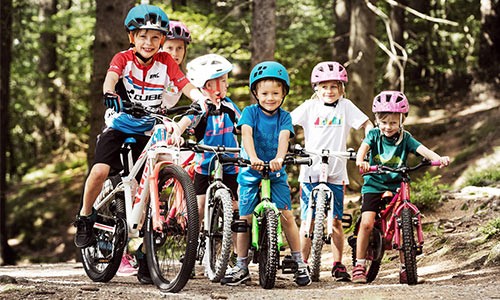
Easy operation makes sense for children. With braking systems, your child should never have to reach around to reach the brakes or the levers of the gears. Turn handles, for example, are usually very well understood by children. A chain guard is essential if they don’t want their favourite trousers to end up in the rubbish, and we also recommend protective pads on the bicycle frame if your little tomboy likes to chase around a bit more.
Wide tyres are good shock absorbers, and your child might do better with a coaster brake. All these points need to be clarified so that the joy of riding remains undiminished – especially for the smallest cyclists. By the way: expensive models with suspension forks are only worthwhile if your child tends towards professional sport.
Safety – a short list
When it comes to our children, we don’t want to leave anything to chance. The German Road Traffic Act (StVo) prescribes a number of things for road safety. If you pay attention to the details, nothing can go wrong. The bicycle should have a clearly audible bell, two independent brakes, front and rear light systems with hub dynamo or rechargeable battery, non-slip pedals with reflectors, rear (red) and front (white) reflectors, two reflectors and two cat’s eyes on the spokes of each wheel.
In addition, a gear shift is always recommended, as well as mud flaps such as mudguards and a chain guard. A kickstand and a sturdy lock should also be included. A luggage rack may be practical, especially if you are planning family trips. Also make sure that the bike does not exceed a maximum weight of 15 kilograms.
What is a youth bike?
Basically, nothing changes except the size. 26 inch bikes are the last step up to adult bikes and are suitable for a body height of 145 cm or more. Smaller adults also use bikes with 26″ wheels.

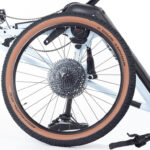

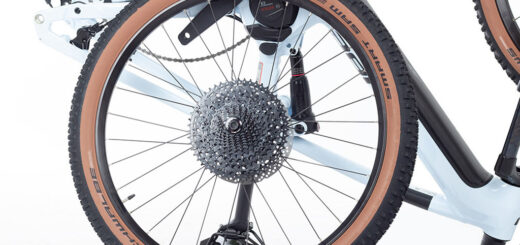
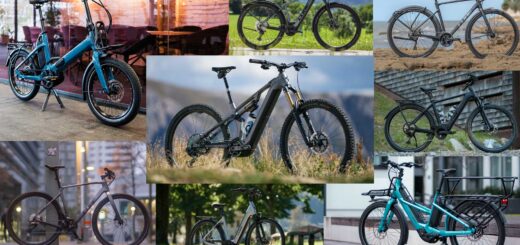








Recent Comments